
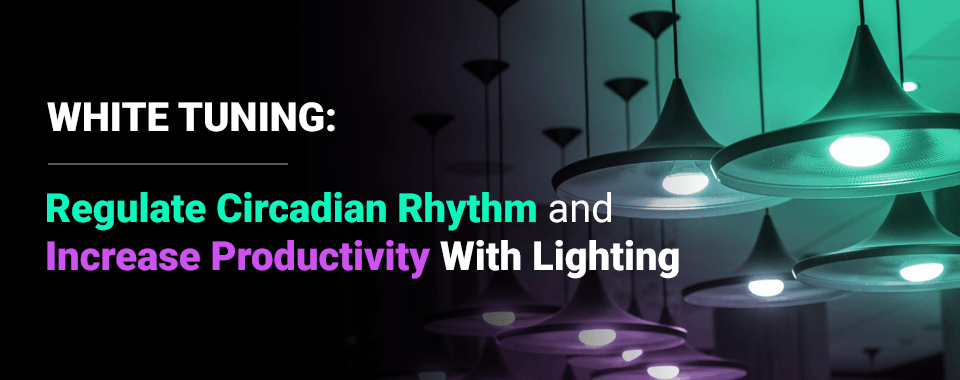
Lighting impacts our bodies continually. Throughout our evolution, daily periods of natural light have regulated our biological clocks, essentially placing our bodies on a schedule that optimizes our exposure to daylight. Artificial light can be just as impactful as natural light, and specific color-tuning techniques can enhance the lighting of an area. Optimal lighting conditions can boost productivity, aid circadian rhythm and provide a more visually pleasing experience for those exposed.
Various lighting techniques can achieve this effect. One method, known as color tuning, involves modifying either the white or red, green or blue light of sources to produce different color temperatures. A form of color tuning, white tuning techniques can successfully adjust the white light to any temperature within set limits without losing intensity. Integrating tunable white lighting into your AVL design is how to regulate circadian rhythm and increase the productivity of the employees, visitors and guests within your facility.
The audio, video and lighting experts at Illuminated Integration are fascinated with the way different lighting configurations can dramatically enhance a space. Our goal is to educate our clients about the importance of light in an AVL design. Using techniques like white tuning, we can create an environment that comfortably caters to your audience. As you begin to visualize your new or upgraded AVL build, consider implementing tunable white lighting to control the way light positively impacts your organization.

As lighting technology has evolved, solid-state lighting has grown in popularity. Solid-state lighting refers to a lighting application that uses LEDs, OLEDs or light-emitting polymers. Fluorescent and incandescent light sources rely on gases and filaments within the lightbulb to create light, while solid-state lighting converts electricity into light via semiconductors. Solid-state lighting has many advantages over incandescent and fluorescent light sources. They provide hundreds of thousands of hours of higher-quality light while conserving energy, they’re structurally safer and they are smaller and more durable.
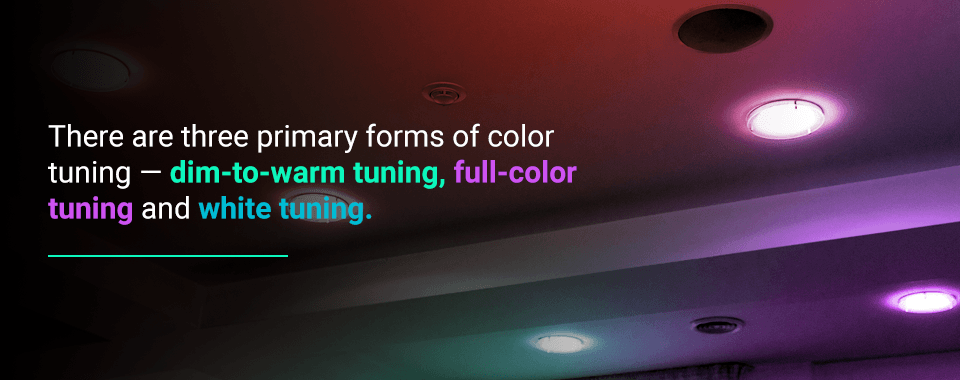
While originally used in a small capacity, LEDs have now become a familiar source of lighting for residential and commercial applications. Industry experts also speculate it will become the most popular form of lighting technology in use. Another benefit to LED lighting is that users can modify and control it to change the way the light impacts its environment. This change is a technique known as color tuning. There are three primary forms of color tuning — dim-to-warm tuning, full-color tuning and white tuning.
Incandescent lights increase in temperature as they glow brighter, creating white-hot filament temperatures when generating maximum output. These lights are dimmable, reducing brightness to create a more intimate environment that makes dining and living spaces comfortable. LEDs of two or more colors can mimic this warm light by emulating the warm color temperatures incandescent dimming lights provide. The shift in color lights an area in a familiar and alluring way, bringing a sense of calm to those who experience it.

Full-color tuning is a lighting technique that doesn’t involve the white color temperature of light. Instead, it produces colors in the visible spectrum, such as red, green and blue. This method can create an array of output colors using multiple base-color LED lights. You’ve likely viewed an area that used full-color tuning — this technique was traditionally in use for the stage and silver screen. However, its ability to be finely tuned to mimic dim-to-warm tuning has expanded its use to private and commercial settings.

The third common way of color tuning is called white tuning. Also called Kelvin changing and tunable white, white tuning is a lighting technique that uses LEDs to adjust the white color temperature and intensity of light in a room. Unlike some incandescent or fluorescent lights that have a set color temperature output, white tuning allows the user to control the temperature and intensity separately to provide flexible, dynamic lighting that people can easily modify to cater to the needs of a specific space.
When light strikes an object, the color of that light and the color of the object influence our perception of that color. Different types of lighting can lend a room a warmer appearance with hues of red and orange, or make a room seem cooler with bluish tints. We measure color temperature on the Kelvin scale — a temperature of 1,500 degrees Kelvin is similar to a match flame, while temperatures exceeding 10,000 degrees Kelvin are approximately the same color as a blue sky. Periods of daylight in Kelvin include:
If you lit a room with only a candle, the color temperature would be around 2,000 degrees Kelvin, which is “warmer” than light at sunrise or sunset. If you used a daylight fluorescent lamp to illuminate a space, its temperature would be roughly 6,500 degrees Kelvin and be slightly “cooler” than the sunlight penetrating through a cloudy sky. Traditional incandescent and fluorescent lighting sources don’t allow you to dramatically change color temperature without changing the fixture or the bulb. Tunable white lighting solves that problem.
With white tuning, you can drastically alter the temperature of a single light source. To change the temperature of light from 3,000 to 3,500 degrees Kelvin, you would have to switch from an incandescent lamp to a neutral white fluorescent bulb. White tuning enables you to not only match the warmth of the incandescent lamp, but it also allows you to raise or lower the temperature from 1,800 to 7,000 degrees Kelvin, which is the equivalent of going from candlelight to daylight with the same light source.
Color tuning is a rapidly growing lighting technique that is seeing widespread use in a range of industries. Though all three technologies offer many benefits, tunable white light is particularly useful in spaces that regularly need to quickly manipulate the lighting of a room to meet specific requirements. With the ability to independently control both color temperature and light intensity, white tuning can dramatically increase the appeal of an area. Perhaps more importantly, it can create an inviting space that is healthier for people.

Light impacts us as soon as it hits our eyes. Too much light can be intrusive, while too little can be inconvenient. The color temperature of a room can either set an ideal mood or create an off-putting aesthetic. Though many of us can immediately recognize its superficial effects — by squinting in a dark room or shielding our eyes from a bright light — some may not be aware of how artificial lighting impacts our health and productivity on a daily, even hourly, basis.
To understand how much of an impact artificial light has on our bodies, you must first understand how our bodies and brains have evolved to respond to natural light. Our body constantly experiences mental, behavioral and physical changes in a daily cycle. These changes are called circadian rhythms, and are a natural biological function of many forms of life, including plants and animals. The amount of light and darkness our body gets exposed to is the predominant influence of circadian rhythms.
Biological clocks within our genetic code produce circadian rhythms, and your health can suffer from incorrectly regulated circadian rhythms. For instance, our biological clocks and circadian rhythms work together to ensure we receive restful sleep. Rhythms influence our sleep patterns, while the clocks control melatonin production. When visible daylight decreases, the body’s master clock instinctively releases melatonin to induce sleep. When this regulation gets disrupted, it can start or stop melatonin production at the wrong times. Circadian rhythm irregularities can also negatively impact other vital bodily functions, like body temperature and digestion.
Since it has such an extreme impact on the body’s functioning, it’s easy to understand how significantly lighting can also influence our energy levels. As our circadian rhythms become disrupted, we can begin to feel drastic effects in our daily lives. Not only can the lighting of the space be an apparent physical distraction, but it also negatively impacts our mental state. Research has found the lighting of a room, such as a workplace or a school, can influence an individual’s level of creativity, depression and productivity.

When artificial light disrupts our hormones, it makes it harder for us to regulate our mood. Our bodies release cortisol to combat periods of stress, but some artificial lighting sources can limit cortisol production and release, which may lead to increased amounts of anxiety and depression or other mental health issues. These stress-inducing environments can take a toll on the body, both mentally and physically. Unhealthy artificial lighting can also fail to mimic natural light, causing people to feel fatigued or exhausted although it’s early in the day. Disruptions to your circadian rhythm are harmful to your physical health, as well, and can increase your risk of obesity, cardiovascular disease and neurological issues. Over the long term, it can lead to sleep disorders, which can cause significant adverse health impacts. Productivity levels are also in jeopardy with harmful artificial lighting.
Not all artificial lighting sources will damage your health or decrease your productivity. With white tuning, you can align lighting with circadian rhythms, create an appropriate mood and encourage productivity. You can also actively minimize the negative impact the artificial light can have on those exposed to it.
White tuning allows you to keep the temperature of the lighting in a building aligned with circadian rhythms. This alignment prevents the disruption of normal sleeping and waking cycles and helps those exposed to the lighting be healthier and more productive. Healthier lighting will make a building more comfortable and pleasant to be in.
By controlling the color temperature of your lights with tunable white lighting sources, you can instantly provide an appropriate environment that caters to the intended atmosphere. We can break the color temperature range into three categories — warm, mid and cool temperatures. Each has their benefit when used in an appropriate environment. Warm lighting below 4,000 degrees Kelvin creates relaxing sensations, while temperatures between 4,000 and 5,000 degrees Kelvin have an inviting, yet semi-stimulating, influence. Cold color temperatures above 5,000 degrees Kelvin are proven to boost mood and alertness. The appropriate temperature range depends on the feel you want a room to have. With white tuning, you can achieve precisely the color temperature you want and even adjust it according to how people are using a space at a given time.
Using cooler lighting in alignment with circadian rhythms can also increase productivity. Cool lighting promotes alertness, focus and creativity, which enables those working under this kind of lighting to accomplish more. White tuning allows you to boost productivity through lighting and adjust the color temperature depending on whether you want to encourage alertness and creativity or relaxation. Using cool lighting in the morning, for example, can help you feel more awake. Because avoiding the disruption of circadian rhythms helps you be healthier overall, it can also increase productivity over the long term.
When replacing fluorescent or incandescent bulbs with a tunable LED lighting system, you can also achieve reduced energy costs. LEDs use 20 to 25 percent of the energy of traditional incandescent bulbs and last 15 to 25 times longer.
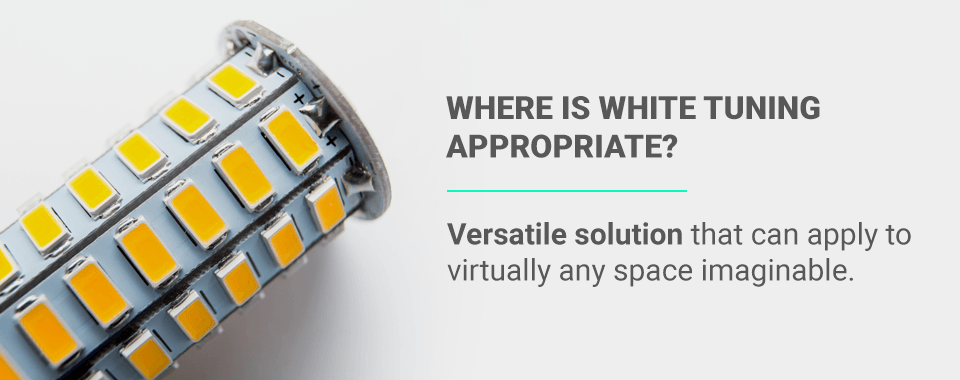
White tuning lighting is a versatile solution that can apply to virtually any space imaginable. From residential homes and private venues to commercial buildings and public facilities, tunable white lighting sources enable users to control the color temperature output and provide individuals with the most favorable environment possible.
Sixty-eight percent of office workers report being unhappy with the lighting in their offices. Applying the right lighting color temperatures in specific areas can make workers more comfortable and increase their productivity.
White tuning enables employers to provide lighting that mimics natural daylight and aligns with circadian rhythms, which keeps workers healthier and happier. Over the long term, this can lead to higher employee satisfaction and fewer sick days for workers. Healthier employees also enjoy their work more and are more productive.
This technology also enables employers to promote productivity, alertness and creativity in the moment. With white tuning, they can adjust the lighting according to the needs of a space and of employees. An office may use bright lighting in the mornings to increase productivity and use warmer lights toward the end of the day to help workers unwind and transition out of the workday. During a brainstorming session, you might use cool lighting to facilitate creativity. Later, if you need to use that room for a casual meeting with a client or an after-work event, you might use warm lighting to promote relaxation and create a homey atmosphere.
The workplace isn’t the only area where increased productivity would yield significant results. Schools are now implementing white tuning to enhance the classroom experience. Teachers are reporting their students are responding positively to classrooms that have tunable white lighting systems. In many cases, educators are using these systems to get students involved in discussions about the classroom environment. By adjusting the color temperature manually, teachers can help prevent disruptions to the children’s sleep-wake cycles and increase their focus during specific learning exercises.
Sleep-wake cycles begin to change as children enter into puberty and adolescence. Instead of relying on manual manipulation of the white tuning system, schools can integrate programmable lighting systems into the classroom. By presetting the white tuning to increase or decrease throughout the day, teachers can create classroom environments that cater to students at specific developmental ages. This transition can occur gradually, so neither the faculty nor the students consciously notice the changes in light.
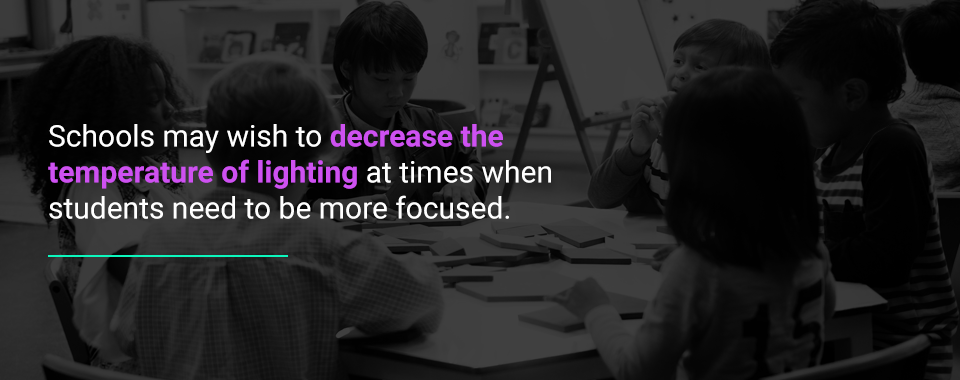
Schools may wish to decrease the temperature of lighting at times when students need to be more focused, such as during regular classroom hours when students are taking tests or participating in discussions. Lighting may even increase student performance. One study of 84 third-graders found students exposed to lighting with temperatures of around 6,000 degrees Kelvin, a temperature known as focus lighting, performed 36 percent better in oral reading fluency. Students exposed to normal lighting performed 17 percent better. Schools may also wish to use warmer lighting to help students relax at other times, such as recess, lunch and independent work periods.
As we discussed above, tunable white lighting benefits any area that requires an adaptable lighting solution. Depending on the application and setting, white tuning can come into play in a variety of ways that each have the flexibility to achieve precise color temperatures along a set range. For example, a simpler system can fluctuate in ranges from 4,000 to 5,000 degrees Kelvin, while others can attempt to achieve a spectrum length of 2,700 to 6,500 degrees Kelvin.
The effects you want to create and your existing lighting conditions will help determine the color temperature you’ll want to achieve and the lighting types you’ll need. A professional AVL company can help you choose the precise lighting equipment you need to get the results you’re looking for.
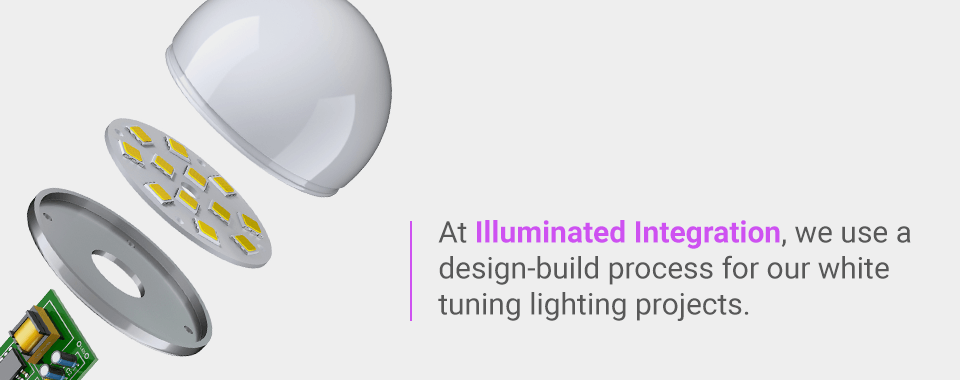
At Illuminated Integration, we use a design-build process for our white tuning lighting projects. We’ll start by meeting with you for a consultation in which we discuss your goals, requirements and expectations. During this stage, we will also map and measure your facility as necessary.
We will use the information from the consultation to determine the color temperatures you need and the equipment, including the bulbs and controllers, required for your project. Once we’ve done so, we’ll create an original design for your tunable while lighting system. After getting feedback from you, we’ll make any necessary changes to the design, then finalize and install it. After installation, we provide long-term support for the system.
This design-build process enables us to provide a complete turnkey solution to our clients. Working with one company through the whole process results in lower costs and a finished product that matches your vision and meets your needs perfectly.
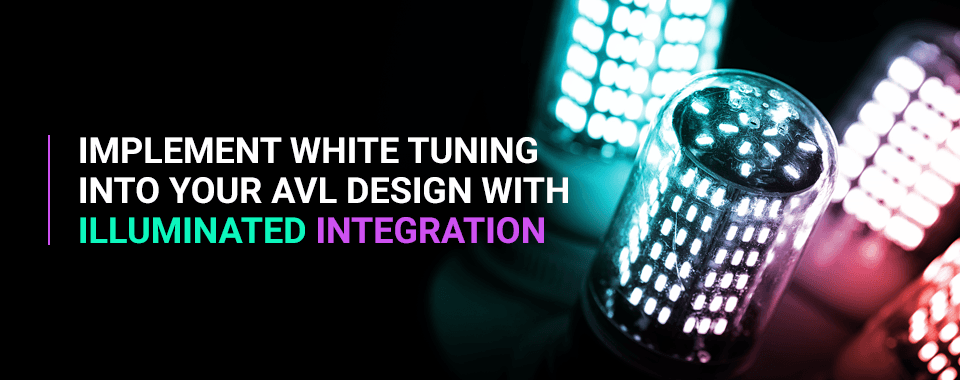
Color tuning is an effective way to limit the light temperature of a space. Using tunable white lighting enables an individual to have an exceptional degree of control over the color temperature of a room and change it as needed. Because color temperature has a direct impact on our biological clocks, circadian rhythms, mood and levels of productivity, having the ability to limit the exposure of disruptive light and enhance the presence of light that mimics natural daylight cycles can help achieve many productivity benefits.
Light matters in every space. Integrating white tuning into your business or school can give you the tools you need to create an environment perfect for any occasion. Illuminated Integration specializes in custom AVL design builds that cater to those you serve. By implementing white tuning into your AVL system, you can easily control the color temperature of light and achieve a healthy and productive atmosphere. Call Illuminated Integration today and learn more about how white tuning can benefit your facility.
Updated on 2/2/2021